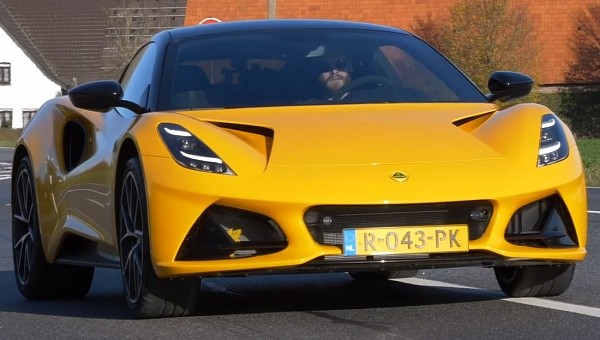It's interesting to see how Lotus cars have evolved in the past few years. You can no longer buy a new Evora, Exige, or Elise, but instead, you can gawk at the Eletre, Emira, and Evija. This transformation feels somewhat similar to the one we've seen over at Mclaren, and we can't wait to see what the British manufacturer is planning on next.
People have started taking delivery of the Emira already, and you know what that means. Some journalists have been lucky enough to get behind the wheel of one already, and with any luck, we might get to that point soon.
We all know that Lotus cars can be quite fun around the racetrack, as high-end performance is embedded in their DNA. That doesn't necessarily mean they'll be lightning-quick in a straight line though. Going fast isn't all about horsepower, and the average speed you'll record around the track is more important than the top speed.
The guys over at Autotop.nl have managed to get their hands on a Hethel Yellow Emira V6. Naturally, they took it out on the freeway for a bit of wide-open-throttle testing. The Toyota-sourced 3.5-liter, supercharged V6 will output a maximum of 400 horsepower and 320 lb-ft (430 Nm) of torque.
In an attempt to make the Emira more user-friendly, it has grown in size quite a bit, compared to the early Elise models. And by quite a bit we mean that it's twice as heavy as a first-generation Elise, at 3,097 lbs (1,405 kg). According to official stats, it should be capable of going from 0 to 60 mph (96 kph) in just over four seconds, with a top speed of 180 mph (290 kph).
But let's just sit back and see how it performs out there in the real world. For the first test of the day, it manages to go from 62 mph (100 kph) to 124 mph (200 kph) in 12.17 seconds. The driver takes it up to 160 mph (261 kph) in fifth gear, and it's impressive to see how accurate the speedometer is compared to the GPS reading.
On the second attempt, the telemetry results are slightly better, with 11.64 seconds required to get up to the same speed as before. It all seems pretty fun, and we can't help but wonder how long it will take for some companies to develop the upgrades needed to make the Emira even faster than it is today.
We all know that Lotus cars can be quite fun around the racetrack, as high-end performance is embedded in their DNA. That doesn't necessarily mean they'll be lightning-quick in a straight line though. Going fast isn't all about horsepower, and the average speed you'll record around the track is more important than the top speed.
The guys over at Autotop.nl have managed to get their hands on a Hethel Yellow Emira V6. Naturally, they took it out on the freeway for a bit of wide-open-throttle testing. The Toyota-sourced 3.5-liter, supercharged V6 will output a maximum of 400 horsepower and 320 lb-ft (430 Nm) of torque.
In an attempt to make the Emira more user-friendly, it has grown in size quite a bit, compared to the early Elise models. And by quite a bit we mean that it's twice as heavy as a first-generation Elise, at 3,097 lbs (1,405 kg). According to official stats, it should be capable of going from 0 to 60 mph (96 kph) in just over four seconds, with a top speed of 180 mph (290 kph).
But let's just sit back and see how it performs out there in the real world. For the first test of the day, it manages to go from 62 mph (100 kph) to 124 mph (200 kph) in 12.17 seconds. The driver takes it up to 160 mph (261 kph) in fifth gear, and it's impressive to see how accurate the speedometer is compared to the GPS reading.
On the second attempt, the telemetry results are slightly better, with 11.64 seconds required to get up to the same speed as before. It all seems pretty fun, and we can't help but wonder how long it will take for some companies to develop the upgrades needed to make the Emira even faster than it is today.









